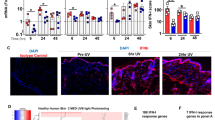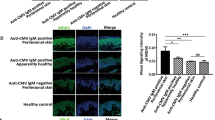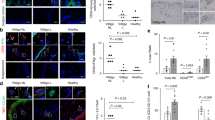Abstract
Interferon (IFN)-λ1, -2 and -3 (also designated as interleukin (IL)-29, IL-28α and IL-28β) represent a new subfamily within the class II cytokine family. They show type I IFN-like antiviral and cytostatic activities in affected cells forming the basis for IFN-λ1 therapy currently under development for hepatitis C infection. However, many aspects of IFN-λs are still unknown. This study aimed at identifying the target cells of IFN-λs within the immune system and the skin. Among skin cell populations, keratinocytes and melanocytes, but not fibroblasts, endothelial cells or subcutaneous adipocytes turned out to be targets. In contrast to these target cells, blood immune cell populations did not clearly respond to even high concentrations of these cytokines, despite an IFN-λ receptor expression. Interestingly, immune cells expressed high levels of a short IFN-λ receptor splice variant (sIFN-λR1/sIL-28R1). Its characterization revealed a secreted, glycosylated protein that binds IFN-λ1 with a moderate affinity (KD 73 nM) and was able to inhibit IFN-λ1 effects. Our study suggests that IFN-λ therapy should be suited for patients with verrucae, melanomas and non-melanoma skin cancers, apart from patients with viral hepatitis, and would not be accompanied by immune-mediated complications known from type I IFN application.
This is a preview of subscription content, access via your institution
Access options
Subscribe to this journal
Receive 6 digital issues and online access to articles
$119.00 per year
only $19.83 per issue
Buy this article
- Purchase on Springer Link
- Instant access to full article PDF
Prices may be subject to local taxes which are calculated during checkout







Similar content being viewed by others
References
Kotenko SV, Gallagher G, Baurin VV, Lewis-Antes A, Shen M, Shah NK et al. IFN-lambdas mediate antiviral protection through a distinct class II cytokine receptor complex. Nat Immunol 2003; 4: 69–77.
Sheppard P, Kindsvogel W, Xu W, Henderson K, Schlutsmeyer S, Whitmore TE et al. IL-28, IL-29 and their class II cytokine receptor IL-28R. Nat Immunol 2003; 4: 63–68.
Pestka S, Krause CD, Sarkar D, Walter MR, Shi Y, Fisher PB . Interleukin-10 and related cytokines and receptors. Annu Rev Immunol 2004; 22: 929–979.
Wolk K, Sabat R . Interleukin-22: a novel T- and NK-cell derived cytokine that regulates the biology of tissue cells. Cytokine Growth Factor Rev 2006; 17: 367–380.
Sabat R, Wallace E, Endesfelder S, Wolk K . IL-19 and IL-20: two novel cytokines with importance in inflammatory diseases. Expert Opin Ther Targets 2007; 11: 601–612.
Doyle SE, Schreckhise H, Khuu-Duong K, Henderson K, Rosler R, Storey H et al. Interleukin-29 uses a type 1 interferon-like program to promote antiviral responses in human hepatocytes. Hepatology 2006; 44: 896–906.
Dumoutier L, Tounsi A, Michiels T, Sommereyns C, Kotenko SV, Renauld JC . Role of the interleukin (IL)-28 receptor tyrosine residues for antiviral and antiproliferative activity of IL-29/interferon-lambda 1: similarities with type I interferon signaling. J Biol Chem 2004; 279: 32269–32274.
Gad HH, Dellgren C, Hamming OJ, Vends S, Paludan SR, Hartmann R . Interferon-{lambda} is functionally an interferon but structurally related to the interleukin-10 family. J Biol Chem 2009; 284: 20869–20875.
Zhou Z, Hamming OJ, Ank N, Paludan SR, Nielsen AL, Hartmann R . Type III interferon (IFN) induces a type I IFN-like response in a restricted subset of cells through signaling pathways involving both the Jak–STAT pathway and the mitogen-activated protein kinases. J Virol 2007; 81: 7749–7758.
Uze G, Monneron D . IL-28 and IL-29: newcomers to the interferon family. Biochimie 2007; 89: 729–734.
Coccia EM, Severa M, Giacomini E, Monneron D, Remoli ME, Julkunen I et al. Viral infection and Toll-like receptor agonists induce a differential expression of type I and lambda interferons in human plasmacytoid and monocyte-derived dendritic cells. Eur J Immunol 2004; 34: 796–805.
Brand S, Beigel F, Olszak T, Zitzmann K, Eichhorst ST, Otte JM et al. IL-28A and IL-29 mediate antiproliferative and antiviral signals in intestinal epithelial cells and murine CMV infection increases colonic IL-28A expression. Am J Physiol Gastrointest Liver Physiol 2005; 289: G960–G968.
Mordstein M, Kochs G, Dumoutier L, Renauld JC, Paludan SR, Klucher K et al. Interferon-lambda contributes to innate immunity of mice against influenza A virus but not against hepatotropic viruses. PLoS Pathog 2008; 4: e1000151.
Robek MD, Boyd BS, Chisari FV . Lambda interferon inhibits hepatitis B and C virus replication. J Virol 2005; 79: 3851–3854.
Lasfar A, Lewis-Antes A, Smirnov SV, Anantha S, Abushahba W, Tian B et al. Characterization of the mouse IFN-lambda ligand-receptor system: IFN-lambdas exhibit antitumor activity against B16 melanoma. Cancer Res 2006; 66: 4468–4477.
Sato A, Ohtsuki M, Hata M, Kobayashi E, Murakami T . Antitumor activity of IFN-lambda in murine tumor models. J Immunol 2006; 176: 7686–7694.
Wolk K, Witte K, Witte E, Proesch S, Schulze-Tanzil G, Nasilowska K et al. Maturing dendritic cells are an important source of IL-29 and IL-20 that may cooperatively increase the innate immunity of keratinocytes. J Leukoc Biol 2008; 83: 1181–1193.
Maher SG, Sheikh F, Scarzello AJ, Romero-Weaver AL, Baker DP, Donnelly RP et al. IFN-alpha and IFN-lambda differ in their antiproliferative effects and duration of JAK/STAT signaling activity. Cancer Biol Ther 2008; 7: nihpa47781.
Meager A, Visvalingam K, Dilger P, Bryan D, Wadhwa M . Biological activity of interleukins-28 and -29: comparison with type I interferons. Cytokine 2005; 31: 109–118.
Ank N, Iversen MB, Bartholdy C, Staeheli P, Hartmann R, Jensen UB et al. An important role for type III interferon (IFN-lambda/IL-28) in TLR-induced antiviral activity. J Immunol 2008; 180: 2474–2485.
Baize S, Pannetier D, Faure C, Marianneau P, Marendat I, Georges-Courbot MC et al. Role of interferons in the control of Lassa virus replication in human dendritic cells and macrophages. Microbes Infect 2006; 8: 1194–1202.
Sommereyns C, Paul S, Staeheli P, Michiels T . IFN-lambda (IFN-lambda) is expressed in a tissue-dependent fashion and primarily acts on epithelial cells in vivo. PLoS Pathog 2008; 4: e1000017.
Wolk K, Kunz S, Witte E, Friedrich M, Asadullah K, Sabat R . IL-22 increases the innate immunity of tissues. Immunity 2004; 21: 241–254.
Dumoutier L, Lejeune D, Hor S, Fickenscher H, Renauld JC . Cloning of a new type II cytokine receptor activating signal transducer and activator of transcription (STAT)1, STAT2 and STAT3. Biochem J 2003; 370 (Part 2): 391–396.
Novick D, Cohen B, Rubinstein M . The human interferon alpha/beta receptor: characterization and molecular cloning. Cell 1994; 77: 391–400.
Kirkwood JM, Tarhini AA, Panelli MC, Moschos SJ, Zarour HM, Butterfield LH et al. Next generation of immunotherapy for melanoma. J Clin Oncol 2008; 26: 3445–3455.
Robak T . Current treatment options in hairy cell leukemia and hairy cell leukemia variant. Cancer Treat Rev 2006; 32: 365–376.
Sievert W . Management issues in chronic viral hepatitis: hepatitis C. J Gastroenterol Hepatol 2002; 17: 415–422.
Weinstock-Guttman B, Ramanathan M, Zivadinov R . Interferon-beta treatment for relapsing multiple sclerosis. Expert Opin Biol Ther 2008; 8: 1435–1447.
Naka K, Takemoto K, Abe K, Dansako H, Ikeda M, Shimotohno K et al. Interferon resistance of hepatitis C virus replicon-harbouring cells is caused by functional disruption of type I interferon receptors. J Gen Virol 2005; 86 (Part 10): 2787–2792.
Dellgren C, Gad HH, Hamming OJ, Melchjorsen J, Hartmann R . Human interferon-lambda3 is a potent member of the type III interferon family. Genes Immun 2009; 10: 125–131.
Jordan WJ, Eskdale J, Boniotto M, Rodia M, Kellner D, Gallagher G . Modulation of the human cytokine response by interferon lambda-1 (IFN-lambda1/IL-29). Genes Immun 2007; 8: 13–20.
Pekarek V, Srinivas S, Eskdale J, Gallagher G . Interferon lambda-1 (IFN-lambda1/IL-29) induces ELR(−) CXC chemokine mRNA in human peripheral blood mononuclear cells, in an IFN-gamma-independent manner. Genes Immun 2007; 8: 177–180.
Mennechet FJ, Uze G . Interferon-lambda-treated dendritic cells specifically induce proliferation of FOXP3-expressing suppressor T cells. Blood 2006; 107: 4417–4423.
Chi B, Dickensheets HL, Spann KM, Alston MA, Luongo C, Dumoutier L et al. Alpha and lambda interferon together mediate suppression of CD4T cells induced by respiratory syncytial virus. J Virol 2006; 80: 5032–5040.
Jordan WJ, Eskdale J, Srinivas S, Pekarek V, Kelner D, Rodia M et al. Human interferon lambda-1 (IFN-lambda1/IL-29) modulates the Th1/Th2 response. Genes Immun 2007; 8: 254–261.
Serra C, Biolchini A, Mei A, Kotenko S, Dolei A . Type III and I interferons increase HIV uptake and replication in human cells that overexpress CD4, CCR5, and CXCR4. AIDS Res Hum Retroviruses 2008; 24: 173–180.
Siebler J, Wirtz S, Weigmann B, Atreya I, Schmitt E, Kreft A et al. IL-28A is a key regulator of T-cell-mediated liver injury via the T-box transcription factor T-bet. Gastroenterology 2007; 132: 358–371.
Srinivas S, Dai J, Eskdale J, Gallagher GE, Megjugorac NJ, Gallagher G . Interferon-lambda1 (interleukin-29) preferentially down-regulates interleukin-13 over other T helper type 2 cytokine responses in vitro. Immunology 2008; 125: 492–502.
Dai J, Megjugorac NJ, Gallagher GE, Yu RY, Gallagher G . IFN-lambda1 (IL-29) inhibits GATA3 expression and suppresses Th2 responses in human naive and memory T cells. Blood 2009; 113: 5829–5838.
Moore KW, de Waal Malefyt R, Coffman RL, O′Garra A . Interleukin-10 and the interleukin-10 receptor. Annu Rev Immunol 2001; 19: 683–765.
Wolk K, Kunz S, Asadullah K, Sabat R . Cutting edge: immune cells as sources and targets of the IL-10 family members? J Immunol 2002; 168: 5397–5402.
Wolk K, Witte E, Hoffmann U, Doecke WD, Endesfelder S, Asadullah K et al. IL-22 induces lipopolysaccharide-binding protein in hepatocytes: a potential systemic role of IL-22 in Crohn's disease. J Immunol 2007; 178: 5973–5981.
Jaitin DA, Roisman LC, Jaks E, Gavutis M, Piehler J, Van der Heyden J et al. Inquiring into the differential action of interferons (IFNs): an IFN-alpha2 mutant with enhanced affinity to IFNAR1 is functionally similar to IFN-beta. Mol Cell Biol 2006; 26: 1888–1897.
Jaks E, Gavutis M, Uze G, Martal J, Piehler J . Differential receptor subunit affinities of type I interferons govern differential signal activation. J Mol Biol 2007; 366: 525–539.
Kalie E, Jaitin DA, Podoplelova Y, Piehler J, Schreiber G . The stability of the ternary interferon-receptor complex rather than the affinity to the individual subunits dictates differential biological activities. J Biol Chem 2008; 283: 32925–32936.
Lamken P, Lata S, Gavutis M, Piehler J . Ligand-induced assembling of the type I interferon receptor on supported lipid bilayers. J Mol Biol 2004; 341: 303–318.
Slutzki M, Jaitin DA, Yehezkel TB, Schreiber G . Variations in the unstructured C-terminal tail of interferons contribute to differential receptor binding and biological activity. J Mol Biol 2006; 360: 1019–1030.
Wolk K, Docke WD, von Baehr V, Volk HD, Sabat R . Impaired antigen presentation by human monocytes during endotoxin tolerance. Blood 2000; 96: 218–223.
Wolk K, Kunz S, Crompton NE, Volk HD, Sabat R . Multiple mechanisms of reduced major histocompatibility complex class II expression in endotoxin tolerance. J Biol Chem 2003; 278: 18030–18036.
Wolk K, Grutz G, Witte K, Volk HD, Sabat R . The expression of legumain, an asparaginyl endopeptidase that controls antigen processing, is reduced in endotoxin-tolerant monocytes. Genes Immun 2005; 6: 452–456.
Wolk K, Witte E, Reineke U, Witte K, Friedrich M, Sterry W et al. Is there an interaction between interleukin-10 and interleukin-22? Genes Immun 2005; 6: 8–18.
Acknowledgements
We acknowledge B Ketel and A Buss for excellent technical assistance and E Wallace for accurately proofreading the paper. This study was supported by research Grant WO 1567/1-1 (to Kerstin Wolk) from the Deutsche Forschungsgemeinschaft (German Research Foundation).
Author information
Authors and Affiliations
Corresponding author
Rights and permissions
About this article
Cite this article
Witte, K., Gruetz, G., Volk, HD. et al. Despite IFN-λ receptor expression, blood immune cells, but not keratinocytes or melanocytes, have an impaired response to type III interferons: implications for therapeutic applications of these cytokines. Genes Immun 10, 702–714 (2009). https://doi.org/10.1038/gene.2009.72
Received:
Revised:
Accepted:
Published:
Issue Date:
DOI: https://doi.org/10.1038/gene.2009.72
Keywords
This article is cited by
-
Interleukin-29 and interleukin-28A induce migration of neutrophils in rheumatoid arthritis
Clinical Rheumatology (2021)
-
Type III Interferons (Lambda Interferons) in Rheumatic Autoimmune Diseases
Archivum Immunologiae et Therapiae Experimentalis (2020)
-
The pattern of antiviral protein expression induced by interferon λ1 in peripheral blood mononuclear cells of patients with chronic hepatitis C virus infection
Archives of Virology (2020)
-
Interferon-λ orchestrates innate and adaptive mucosal immune responses
Nature Reviews Immunology (2019)
-
IL28RA inhibits human epidermal keratinocyte proliferation by inhibiting cell cycle progression
Molecular Biology Reports (2019)



